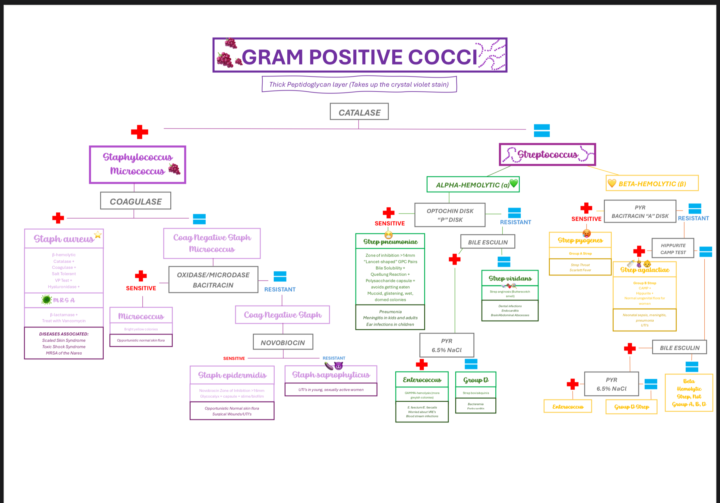Activity
Mon
Wed
Fri
Sun
Oct
Nov
Dec
Jan
Feb
Mar
Apr
May
Jun
Jul
Aug
Sep
What is this?
Less
More
Memberships
Microscope Views (FREE)
1k members • Free
5 contributions to Microscope Views (FREE)
Microbiology CHEAT CODES: Flow Charts for Gram-Positives & Gram-Negatives
Greetings my Little Gang of Nasties 😈😜 Today we’re breaking down the basics of Gram-positives vs Gram-negatives in Microbiology. Attached, you’ll find two flow charts: use these as much as you can when answering your practice questions. The more you use them, the faster it’ll become second nature when you see those bacteria show up on your exam. 🦠 Gram-Positives (Purple!) • Cell wall: Thick peptidoglycan layer → holds onto crystal violet stain. • Examples: Staphylococcus, Streptococcus, Bacillus, Clostridium, Listeria. • Biochemicals you’ll use a lot: Catalase, Coagulase, Hemolysis patterns, Bile esculin, 6.5% NaCl, Optochin & bacitracin sensitivity 👉 TSI Slant for Gram-Positive Rods (like Bacillus or Listeria): usually A/A (acid slant/acid butt), but Clostridium can be variable depending on species. 🦠 Gram-Negatives (Lactose and Non-Lactose Fermenters) • Cell wall: Thin peptidoglycan layer + outer membrane with LPS. • Examples: Enterobacteriaceae (E. coli, Salmonella, Shigella, Klebsiella), Pseudomonas, Neisseria, etc. • Biochemicals to remember: Oxidase, Indole, Urease, Citrate, H2S production. 👉 TSI Slant for Gram-Negative Rods: • E. coli: A/A (acid slant/acid butt), gas, no H2S • Salmonella: K/A (alkaline slant/acid butt), H2S positive • Shigella: K/A, no H2S • Klebsiella: A/A, gas • Pseudomonas: K/K (alkaline slant/alkaline butt) = non-fermenter 🔑 Tip: Your flow charts and TSI reactions are your cheat codes. Use them over and over until you don’t even need to think… you’ll just know the answer. Now go run through some practice questions using the charts. The more you do, the more this sticks, and the faster you’ll dominate your exam. -Marilyn 🧪✨ Interested in studying with other students for your ASCP exam? Weekly study session available in the Inner Circle of Microscope Views. Click here to join now, or book a 1:1 call with me to assess your needs! https://www.skool.com/microscopeviews/about?ref=badbb26c40a147eea94634972a25414a

🧪 Urinalysis: Stop Just ID’ing Stuff
Hello my Little Gang Of Nasties 😜😈 @Eddllyn Mactavious asked and yall shall receive! If all you’re doing in UA is memorizing “that’s a cast, that’s a crystal, that’s a cell,” you’re missing the point, and you’re making the exam harder for yourself. Urinalysis is about translating those findings into the patient’s story. That means: - Seeing abnormal cells and asking, “What’s happening in this patient’s body right now?” - Matching pH, color, and microscopy results with specific disease processes - Recognizing the pattern, not just the part 💡 Pro tip: Start your UA/Body Fluids study sessions with practice questions based on disease states: glomerulonephritis, pyelonephritis, UTI, kidney stones, etc. Work backwards from the symptoms and case data → to the results → to the diagnosis. That’s how you train your brain to think like the exam (and like a real laboratorian). 🚨 If UA/Body Fluids was one of your lowest scoring subjects: Hammer it. Do 50 practice questions per day in just that section until your pattern recognition improves. Repetition is how you rewire your brain to see the correlations instantly. 📊 Use the Urine Crystal Chart I’ve attached to this post to help you connect findings to possible disease processes faster. Keep it pulled up while you do practice questions until it becomes second nature. 💬 What’s one UA-related disease process you keep mixing up? 🫠 Tired of guessing what to study and feeling lost in the process? Book a 1:1 call with me and we’ll build you a personalized plan that actually works. https://calendly.com/microscopeviewsyt/45min
7 likes • Aug 11
Can you do something similar to this but for hemeatology? That’s my weakest area especially reading the MCV, MCH, MCHC and the anemias that go along with it. Like how do I interpret all that info given from CBCs and how to not get lost in “junk” information that’s normal/unrelated to the question?
Anki Decks?
Do you guys use anki for studying or just hardcore use practice questions from LabCE/ASCP interactive? I want to use anki to use it on my phone but idk how to make good anki cards ( and the decks I found online are usually focused on Med Students 🥲). So if any of you guys know any good decks please lmk 🙏.
🧫 ASCP Practice Question Breakdown
🤔Carla expresses the blood group antigens Fya, Fyb, and Xga. James shows expressions of none of these antigens. What factor(s) may account for the absence of these antigens in James? 💭This is what I would be thinking about when attempting to answer this question: - What are the keywords? - What is a key difference between Carla and James? - How and why are the Duffy's significant in this case? - How and why is Xga significant in this case? - Do I know my blood group systems and their prevelance/significance? Answer the correct answer using the poll below and comment your though process under this post! ⬇️
Poll
49 members have voted
1 like • Jul 25
Here is my thought process when looking at the question. So i directly took at the antigens and see they are Fya,Fyb, and Xga. I know that Xga is sex-linked (bc of big X 😂) so it is mostly seen in males (i.e. gender specific). I then go to Fya/Fyb I remember them being more prevalent ( don’t quote me on this) in either African American population or Caucasian population or Asian population (again don’t quote me lol) but I know it is dependent on race. So taking all that into consideration, I believe the (most right) answer would be C. gender and race 😊
[START HERE] Welcome to the Microscope Views Community 🦠🔬😋
👋🏾 Hello, my little Gang of Nasties! I’m really glad you’re here. This space was made specifically for students and future lab professionals who are trying to study smarter, stay motivated, and finally pass the ASCP exam without losing their minds. Whether you’re still in school, prepping for boards, or coming back after a break—this is your space. 👇 Introduce yourself to our FREE Community: 1. What’s your name? 2. Where are you in your lab journey (Student? Graduated already?) 3. Which department is your biggest struggle? 4. Which department is your favorite? I’ll go first… My name is Marilyn, aka @marilynthescientist 👩🏾🔬 I’m a Clinical/Medical Laboratory Scientist with 10 years of experience in the field. 💉 I’ve worked everywhere—from tiny Critical Access Hospitals to busy Level 1 Trauma Centers. 🧳 6 of those years were spent traveling across the U.S. 🩸 Currently, I’m holding it down as a Blood Bank Supervisor in California. This space is here for us to learn, laugh, rant, and master the lab world together. No dumb questions, EVER! 📲 Follow me on socials if you want extra lab tips, rants, and ratchet breakdowns: Instagram | TikTok 🧬 If you ever have questions—even the “silly” ones—DM me or post them in the group. 😤💅🏾
1 like • Jul 25
@Marilyn Virgo yeah but it was part of my MLS program after undergrad in bio. I take my exam Aug 5th (not a lot of time left) but idk I fell totally unprepared and when I do try to sit down and study I just don’t have the motivation/idk where to begin especially in hematology and micro!!
1 like • Jul 25
@Marilyn Virgo I’m honestly lost in hematology bc I honestly don’t know how to attack the questions especially case studies with all the values you have memorize like for Anemias and disorders. I also SUCK at GNR for micro bc they all seem to feel the same to me (and don’t even get my started on the bs that are biochemical tests) I am using the bottom line approach (aka purple and gold book) and LabCE/interactive BOC with some Harr questions. The thing is when I study I am tore between taking practice tests/questions or reviewing/making condensed notes (key info) on my wear areas.
1-5 of 5
@aldo-vivero-6863
I’m a 26 year old Latino from Chicago! On my way to become a Lab Scientist or I’ll die trying 😅
Active 8h ago
Joined Jun 24, 2025
Powered by


